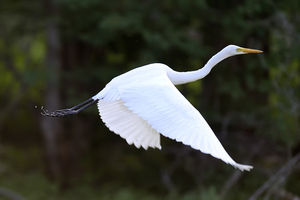Difference between revisions of "Bird's Beak"
| Line 1: | Line 1: | ||
| − | [[File:Egret.jpg|300px|thumb| | + | [[File:Egret.jpg|300px|thumb|right|''Picture of whole egret including its beak found on endoscopy January 2014 and released shortly thereafter back into the wild'']] |
The '''bird's beak''' refers to not only one but two findings in patients with achalasia. Classically, a '''bird's beak''' appearance is noted along with a dilated esophagus on barium swallow. The lesser known but truer '''bird's beak''' is when upper endoscopy reveals an actual '''bird's beak''' and sometimes a whole bird's head lodged at the [[GE Junction|GE junction]] thus causing dysphagia and regurgitation. | The '''bird's beak''' refers to not only one but two findings in patients with achalasia. Classically, a '''bird's beak''' appearance is noted along with a dilated esophagus on barium swallow. The lesser known but truer '''bird's beak''' is when upper endoscopy reveals an actual '''bird's beak''' and sometimes a whole bird's head lodged at the [[GE Junction|GE junction]] thus causing dysphagia and regurgitation. | ||
| Line 7: | Line 7: | ||
---- | ---- | ||
The treatment for a true '''bird's beak''' on endoscopy is to remove the '''bird's beak''' and other bird parts. In rare instances, you might find a whole live bird. Do not forget to send to pathology to determine what type of bird it is. Pigeons are the most common, though rare '''bird's beaks''' include the Asian crested ibis, red-crowned crane, and orange-bellied parrot. | The treatment for a true '''bird's beak''' on endoscopy is to remove the '''bird's beak''' and other bird parts. In rare instances, you might find a whole live bird. Do not forget to send to pathology to determine what type of bird it is. Pigeons are the most common, though rare '''bird's beaks''' include the Asian crested ibis, red-crowned crane, and orange-bellied parrot. | ||
| + | |||
| + | |||
| + | '''Related Reading''' | ||
| + | ---- | ||
| + | - [http://gomerblog.com/2017/02/butterflies-stomach/ Butterflies in the Stomach] | ||
| + | |||
| + | - [[Cheetah]] | ||
| + | |||
| + | - [[King Cobra]] | ||
| + | |||
| + | - [[Pandamonium]] | ||
| + | |||
| + | - [[Pigtail Catheter]] | ||
| + | |||
| + | - [[Three Wise Monkeys]] | ||
[[Category:Gastroenterology]] | [[Category:Gastroenterology]] | ||
[[Category:Cardiothoracic Surgery]] | [[Category:Cardiothoracic Surgery]] | ||
[[Category:Veterinary Medicine]] | [[Category:Veterinary Medicine]] | ||
Revision as of 18:34, 2 March 2017
The bird's beak refers to not only one but two findings in patients with achalasia. Classically, a bird's beak appearance is noted along with a dilated esophagus on barium swallow. The lesser known but truer bird's beak is when upper endoscopy reveals an actual bird's beak and sometimes a whole bird's head lodged at the GE junction thus causing dysphagia and regurgitation.
Treatment
The treatment for a true bird's beak on endoscopy is to remove the bird's beak and other bird parts. In rare instances, you might find a whole live bird. Do not forget to send to pathology to determine what type of bird it is. Pigeons are the most common, though rare bird's beaks include the Asian crested ibis, red-crowned crane, and orange-bellied parrot.
Related Reading
- Cheetah

